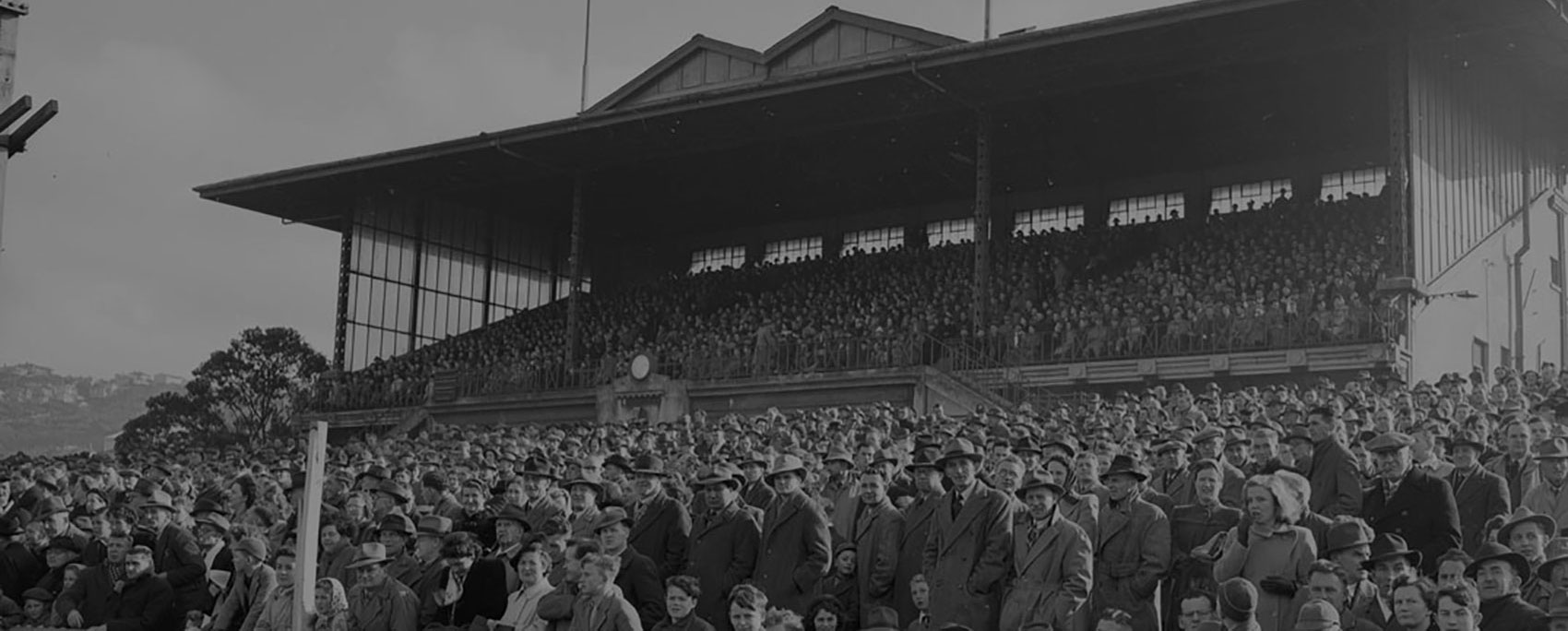
Basin Event History
Over the years, the Basin has played host to many.AFL
The history of the very Australian game of Aussie Rules in Wellington goes back to the early 1900s with matches at the Basin Reserve played under the “Australian rules”. The city’s first taste of the professionalism of the AFL came in 1998, when the Melbourne Demons and Sydney Swans played an exhibition game in front of 8000 fans at the Basin Reserve.
Athletics
While cricket was the first sport to be played on the Basin Reserve, it was followed closely after by other pursuits as athletics quickly found a place here. The Basin Reserve was home to Harry Kerr, the walker who would deliver our first Olympic medal, and Jean Wilson, one of the first women to compete at the Olympics. The Basin Reserve’s place as Wellington’s home of athletics would draw to a close in the 1960s.
Basketball
Since their formation in 1927, the Harlem Globetrotters have travelled the world peddling their brand of razzle-dazzle basketball. When they visited Wellington for the first time in 1957, the lack of a suitable indoor venue saw a wooden court laid at the Basin Reserve, right in front of the Museum Stand.
Swimming
Established in the 1930s, Sam Snyder’s Water Follies was one of the world’s greatest aquatic exhibitions when it visited Wellington in 1957. Featuring diving, synchronised swimming, and water ballet displays, the Water Follies saw the build of one of the most unusual structures in the Basin Reserve’s history: a swimming pool. Snyder’s performers brought two pools with them; an 8-foot deep diving pool and a 75-foot long exhibition pool.
Boxing
Boxing does not have a long history at the Basin Reserve, but the events held here have been notable. At Easter 1943, the ground saw a full programme of fights take place between the army and American marines. Later, in 1954, a New Zealander would claim the British Empire title under lights at the Basin Reserve. The bout pitted South Africa’s Gerald Reyer, an Olympic gold medallist, against New Zealand’s Barry Brown. Brown dominated the fight before it was stopped in the seventh round.
Woodchopping
The summer of 1940 was a hectic one for the Basin Reserve. Between late-January and early-March, the ground hosted four major athletics meetings, including the Centennial Championship. At this event, athletics and cycling were joined by wood-chopping competitions, a first for the ground.
Baseball & Softball
Of the American sports played in 1800s’ New Zealand, baseball perhaps benefited most from the place of cricket as our national game as many players crossed codes. In Wellington, the first recorded baseball game was played between Wellington and the, suitably American-sounding, Hick’s Sawyer Ministrels at the Basin Reserve in 1889. The first national provincial softball championship was played for the Beatty Cup at the Basin Reserve in 1939. Auckland were decisive champions, beating Wellington 20-0 in the final.
Wrestling
The Basin Reserve was the finish line for 1931’s Palmerston North to Wellington cycling road race. With the first cyclists expected to arrive after 3.30pm, an athletic meeting was scheduled to entertain the crowds. Alongside the usual running and cycling events, the day’s programme also included amateur wrestling. With the majority of the outfield in use for the athletic sports, spectators watched the action in the ring from the boundary edge.
Gymnastics
Like many sports, gymnastics found its place at the Basin Reserve as an exhibition sport to entertain fans in the midst of larger athletics meets and community events. The heyday for gymnastics at the ground came through the 1930s when Alf Jenkins, who ran a local gym, often bought his students along to show off their feats of strength and balance.
Cycling
For many years, cycling events at the Basin Reserve were held alongside athletics meets, both sports sharing the outfield. In 1926 further excitement was added to cycling events at the ground when electric lights were installed to provide the opportunity to hold races at night. Events continued in to the 1950s and several national grasstrack records still belong to the Basin Reserve.
Football
Football was granted regular access to the Basin Reserve from 1908, but the 1920s signalled its emergence as New Zealand’s major football ground. First played for in 1923, the Chatham Cup is still the feature trophy of New Zealand domestic football. In 1926 the final was first played at the Basin Reserve where it would be held until 1972. Through the 1970s and 80s European club sides regularly visited to play New Zealand in exhibition matches. These teams included Luton Town, Newcastle United, Moscow Locomotiv, Wolverhampton Wanderers and Werder Bremen.
Rugby League
Rugby league’s first appearance at the Basin Reserve came in 1914 when England beat Wellington 14-7. Even though this match was a positive start, rugby league’s growth stalled as the Wellington Provincial Rugby Football League struggled to secure a ground. In 1919, after the City Council’s initial rejection to their use of the Basin Reserve was reversed, the ground became the official home of rugby league in Wellington.
Marching
Marching is a proudly New Zealand invention, developed out of YMCA sports carnivals in the 1920s. From these early days, displays could often be seen at the Basin Reserve. When the first Inter-Dominion marching competition was held between New Zealand and Australia in 1977, the Basin Reserve played host to the event which was won by hometown team, Lochiel.
Hockey
Before the National Hockey Stadium was in the 1980s, the Basin Reserve intermittently held hockey internationals. Among the early visitors to the ground were the Australian men’s and English women’s sides. When New Zealand played the English women’s side in 1914, it was the first hockey Test ever played in this country.
Lacrosse
Lacrosse is a fairly unfamiliar sport to most New Zealanders, but it has a long history in Wellington with the first reports to it being played here dating back to 1888. Like most sports in the capital, lacrosse quickly found a home at the Basin Reserve where regular club matches were held before WWI.
Rugby
In August 1870, the Basin Reserve was the scene of an historic first as the first game of rugby was played in the North Island. While Athletic Park and the Wellington Regional Stadium have been the home of top flite rugby in Wellington, club rugby has regularly been played on the Basin Reserve throughout its history. Today, the Basin is the home ground of the Old Boys University club and is regularly used by touring international sides for training.
Foundation
In 1857 citizens began to petition the Provincial Council for a site to create a permanent cricket ground. With the city growing rapidly, cricket fields were being built upon as quickly as they were developed and the English settlers passion for the game would not abate. The Council approved the petition and gave them the site they desired, Smith’s former Basin at Te Aro. It was no small task turning this swampy piece of land into a ground suitable for cricket and recreation. However, the prison at the nearby Mt Cook barracks offered free labour and, in February 1863, prisoners began the task of flattening and draining the new Basin Reserve. While the work to reclaim land from the earthquake-inspired swamp was successful, the Basin Reserve’s place as the home of cricket was not confirmed until the first game was played here on January 11 1868. Cricket’s love affair with the Basin Reserve had begun.
Earthquake
When Surveyor-General, Captain William Mein Smith, drew up plans for Wellington in 1840, a stream linked the harbour to a lagoon that he simply labelled ‘Basin’. Smith’s intention was for this Basin to become a safe harbour for ships, accessed through a canal to the harbour. Over the next fifteen years the city continued to develop around Smith’s Basin as people from around the world moved to the new colony. Then, in 1855, an earthquake changed everything. At 9.11pm on January 23, an earthquake, estimated at a magnitude of 8.2, struck. Centred in the Wairarapa, the quake had a profound effect on Wellington’s landscape, creating a new shoreline which increased the city’s footprint and made the Hutt Valley more accessible. It also saw the land through Te Aro rise by about 1.5m metres, turning Smith’s Basin into a swamp.
